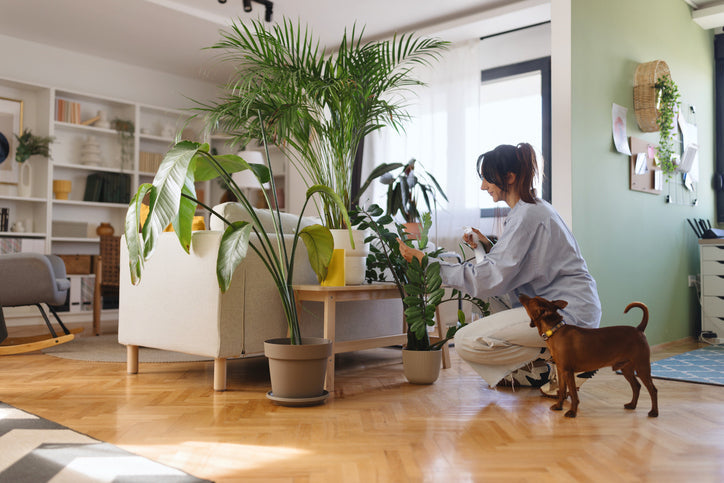
Spring Safety: Common Household Plants That Are Dangerous to Pets
Spring brings beautiful blooms, vibrant greenery, and the perfect opportunity to spruce up your home with plants. While many houseplants are perfectly safe for pets, some can be incredibly toxic, posing a serious risk to your furry friends. Whether your pet is a curious cat or a playful dog, it's important to be aware of which plants can cause harm if ingested. Here’s a guide to common household plants that are dangerous to pets and how you can keep your pets safe this spring.
1. Lilies
Lilies are stunning flowers commonly found in gardens and homes, especially in spring. However, they are highly toxic to cats and can cause severe kidney failure if ingested. Even small amounts of pollen or water from the vase can be dangerous. If you have a cat, it's best to avoid bringing lilies into your home altogether.
2. Azaleas
Azaleas are another popular spring plant with beautiful, colorful flowers. Unfortunately, they contain grayanotoxins, which can cause vomiting, diarrhea, drooling, and even more severe symptoms like low blood pressure and heart arrhythmias if ingested. These plants are toxic to both dogs and cats, so be cautious if you have pets that enjoy nibbling on plants.
3. Tulips
Tulips are a classic spring flower, but they contain compounds called tulipalin A and B that are toxic to both dogs and cats. Ingesting even small amounts of tulip bulbs can cause nausea, drooling, loss of appetite, and digestive upset. Keep tulip bulbs out of reach, as they are the most toxic part of the plant.
4. Daffodils
Daffodils are bright and cheerful flowers, but they can be dangerous for pets if ingested. The bulbs, in particular, are toxic and can cause symptoms like vomiting, diarrhea, and abdominal pain. In severe cases, ingesting daffodils can lead to heart arrhythmias and low blood pressure. Keep daffodils in areas your pets can’t access, especially the bulbs, which are often buried in the soil.
5. Oleander
Oleander is a highly toxic plant that is often used in gardens and landscaping. It contains compounds that affect the heart and can lead to symptoms like drooling, vomiting, diarrhea, and even death if ingested. Both dogs and cats are at risk, so it’s essential to keep oleander out of reach and avoid planting it in areas where your pets roam.
6. Sago Palm
Sago palms are beautiful decorative plants commonly seen in homes and gardens, but they are extremely toxic to pets, especially dogs. The seeds of the sago palm contain toxins called cycasin, which can cause liver failure, vomiting, diarrhea, and even death if ingested. If you have a sago palm in your home or yard, keep it well out of your pet’s reach.
7. Autumn Crocus
Though the autumn crocus is more commonly seen in the fall, it can also bloom in spring. This plant contains colchicine, a substance that can cause severe gastrointestinal distress, liver damage, and kidney failure if ingested. Cats and dogs alike can be affected, so it's important to keep this plant away from pets and dispose of any fallen flowers or leaves.
8. English Ivy
English ivy is a common houseplant that can cause gastrointestinal upset if ingested by pets. While it may not be as dangerous as some of the other plants on this list, it can still cause symptoms like vomiting, diarrhea, and excessive drooling in both dogs and cats. Be mindful of where you place ivy, especially if you have pets that tend to chew on plants.
9. Dieffenbachia (Dumb Cane)
Dieffenbachia, also known as "dumb cane," is a popular houseplant known for its striking foliage. However, it contains oxalate crystals that can cause intense irritation and swelling of the mouth, throat, and digestive tract when ingested. While not typically life-threatening, the symptoms can cause your pet significant discomfort. If your pet chews on plants, it’s best to keep this one out of their reach.
10. Pothos (Devil’s Ivy)
Pothos is another common houseplant that can be toxic to pets. While it's a low-maintenance, attractive plant, it contains insoluble calcium oxalates that can irritate the mouth and digestive tract if ingested. Ingesting pothos can lead to drooling, vomiting, and difficulty swallowing. Keep pothos plants in places where your pets cannot access them.
How to Keep Your Pet Safe from Toxic Plants
-
Research Before Bringing Plants Home: Before adding any new plants to your home or garden, make sure they are safe for pets. Many plant stores and online resources offer lists of pet-friendly plants.
-
Keep Plants Out of Reach: If you have plants that are toxic to pets, place them in areas that are completely inaccessible to your pets. Hanging baskets, high shelves, or rooms that are off-limits can be good options.
-
Educate Your Family: Make sure everyone in your household knows which plants are toxic and how to handle them properly. If you have small children, educate them as well, as they may unknowingly give plants to pets.
-
Monitor Your Pets: If your pet is prone to chewing on plants, keep a close eye on them during spring when plants are more likely to be in bloom. If you notice any signs of poisoning, contact your vet immediately.
A Pet-Safe Spring Season
By staying aware of the plants in your home and garden and taking steps to protect your pet, you can enjoy the beauty of spring without the worry of accidental poisoning. Keeping toxic plants out of reach and being mindful of your pet’s behavior around them will ensure a safe and happy season for your furry companions.


